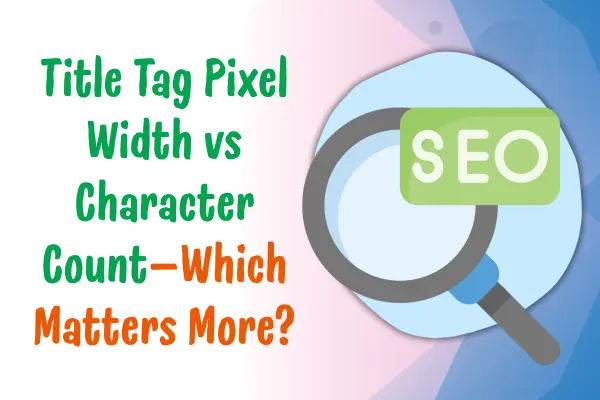When it comes to SEO, your title tag is like the shiny shop sign outside a store. It’s the very first thing people notice on Google before deciding whether to step in (or scroll past). Writing the perfect title is not just about stuffing keywords — it’s about making your headline so irresistible that readers can’t help but click.
But here’s the catch: Google doesn’t measure titles by characters alone. It measures them by pixels. That’s where the idea of a pixel check comes in. If your title is too long, it gets cut off with those annoying “…” ellipses. If it’s too short, it might not make a strong impact. So the golden question is — how to write SEO titles with pixel check that actually boost clicks?
This guide will break it down step by step, in simple language, and by the end you’ll know exactly how to craft titles that rank high and pull in traffic.
Why SEO Titles Matter More Than You Think
Think of your SEO title as the headline of your story. On Google search results, people only see:
- Your title tag
- Your URL
- Your meta description
Out of these, the title is the most eye-catching. A boring or badly optimized title can bury even the best content. On the other hand, a smart, engaging title can skyrocket your CTR (click-through rate), which tells Google, “Hey, people love this page!” — and that means better rankings over time.
Your title does two big jobs:
- Tell Google what your page is about (keyword relevance).
- Convince the user to click (emotional pull).
Balancing these two is an art. That’s why learning how to write SEO titles with pixel check is the secret weapon every website owner needs.

The Pixel vs. Character Debate
Most people think SEO titles are just about characters — usually 50–60 characters. But Google doesn’t really “see” characters, it sees pixels. Each letter takes up different pixel space. For example:
- “W” and “M” take up more space.
- “i” and “l” are skinny and use fewer pixels.
This means two titles with the same number of characters can display completely differently in Google. One might fit perfectly, while the other gets cut off.
👉 That’s why a pixel check tool is so important. Instead of guessing, you can preview how your title will appear on Google and adjust it until it looks perfect.
If you’re serious about snippet optimization, this is the step you should never skip.
How to Write SEO Titles With Pixel Check
Let’s walk through the actual process of writing titles that get clicks and fit within Google’s pixel width.
1. Start With Your Primary Keyword
Your primary keyword should appear at the beginning of the title whenever possible. In our case: how to write SEO titles with pixel check.
Example:
“How to Write SEO Titles With Pixel Check That Actually Boost CTR”
This instantly tells both Google and readers what the page is about.
2. Add a Value Hook
A title without a hook is like a sandwich without filling. It’s plain. The hook is the part that makes people curious or promises value.
Examples of hooks:
- “…That Boost Clicks”
- “…The Secret Google Won’t Tell You”
- “…For Higher Rankings in 2025”
Adding a hook not only improves CTR but also makes your snippet stand out.
3. Keep an Eye on Pixels, Not Just Characters
After drafting your title, run it through a pixel check tool. If it’s too wide, shorten words or rephrase without losing meaning.
Instead of:
“How to Write SEO Titles With Pixel Check That Improve CTR and Rankings”
You could trim it to:
“How to Write SEO Titles With Pixel Check to Improve CTR”
Still keyword-rich, still engaging, but within the pixel width.
4. Make It Human-Friendly
Google loves keywords, but humans hate robotic titles. Always write in a conversational tone. Ask yourself: Would I click this if I saw it on Google?
Example of robotic title:
“SEO Title Pixel Check Improve CTR Snippet Optimization”
Better version:
“How to Write SEO Titles With Pixel Check (Boost CTR Fast)”
See the difference? One looks like it was written for a machine, the other for a person.
5. Use Emotional and Power Words
Words like Boost, Secret, Ultimate, Proven, Easy, Fast, Effective grab attention. People are more likely to click when a title makes them feel like they’ll gain something.
For example:
“How to Write SEO Titles With Pixel Check (Proven CTR Hacks)”
6. Test Multiple Variations
Don’t settle for your first draft. Write 4–5 variations and check them through a pixel preview tool. Choose the one that feels powerful yet fits perfectly in Google’s display width.

Why Pixel Check Improves CTR Titles
CTR (Click-Through Rate) is heavily influenced by your title’s readability and visibility. Imagine spending hours writing an amazing blog post only for your title to get chopped off in search results. That missing half could be the very part that convinced users to click.
By using a pixel check, you ensure your full message is seen. More visibility = more trust = more clicks. This is the foundation of snippet optimization.
Think of it as the difference between a billboard where half the sentence is missing, versus one that’s clean and complete. Which one would you pay attention to?
Snippet Optimization: Beyond Just the Title
While the title tag is the star of the snippet, don’t forget the supporting cast:
- Meta description → Expands on your title’s promise.
- URL structure → Clean, keyword-rich URLs look trustworthy.
Together with your optimized title, these elements create a snippet that stands out in the crowded search results.
Mistakes to Avoid When Writing SEO Titles
- Keyword stuffing – makes the title unreadable.
- Being too vague – people need a clear reason to click.
- Exceeding pixel width – gets cut off and loses impact.
- Ignoring emotional triggers – boring titles get ignored.
- Writing for bots, not humans – always write for people first.
Putting It All Together: A Winning Formula
Here’s a simple structure you can follow every time:
[Primary Keyword] + [Pixel-Checked Length] + [Hook/Value]
Examples:
- “How to Write SEO Titles With Pixel Check (Boost CTR Fast)”
- “How to Write SEO Titles With Pixel Check for Snippet Optimization”
- “How to Write SEO Titles With Pixel Check That Improve CTR”
Each one balances keywords + readability + emotional appeal, all while fitting perfectly in Google’s preview.
FAQs on How to Write SEO Titles With Pixel Check
1. What is a pixel check for SEO titles?
A pixel check shows how many pixels your title uses so you can make sure it fits within Google’s display limit (around 580–600px).
2. Why does Google use pixels instead of characters?
Because letters take up different amounts of space. “W” is wider than “i.” Pixel measurement ensures accuracy.
3. How long should an SEO title be?
Ideally between 50–60 characters, but always confirm with a pixel check.
4. How does a pixel check improve CTR?
By ensuring your title is fully visible in search results, so readers see the complete message and are more likely to click.
5. Can I add brand names in titles?
Yes, especially if your brand is recognized. Just make sure it doesn’t push your primary keyword out of the pixel width.
6. Do emojis in titles affect pixel width?
Yes. Emojis are wider and take up more pixel space, so use them carefully.
Final Thoughts
Learning how to write SEO titles with pixel check is not just an SEO trick — it’s a mindset. You’re not writing for algorithms, you’re writing for humans who make split-second decisions on whether to click your page.
When your titles are keyword-rich, pixel-checked, emotionally engaging, and human-friendly, you don’t just rank higher — you also earn more clicks. And at the end of the day, that’s what really drives traffic, growth, and conversions.
So next time you craft a headline, don’t just count characters. Check the pixels, add a powerful hook, and watch your CTR rise.
